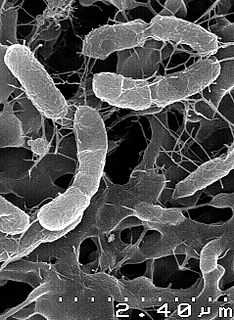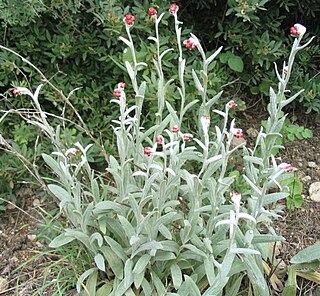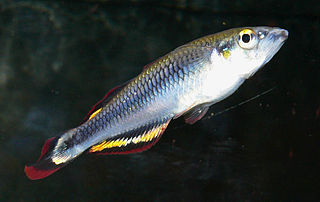
The Aquificae phylum is a diverse collection of bacteria that live in harsh environmental settings. The name 'Aquificae' was given to this phylum based on an early genus identified within this group, Aquifex, which is able to produce water by oxidizing hydrogen. They have been found in springs, pools, and oceans. They are autotrophs, and are the primary carbon fixers in their environments. These bacteria are Gram-negative, non-spore-forming rods. They are true bacteria as opposed to the other inhabitants of extreme environments, the Archaea.

The Celastraceae, are a family of 96 genera and 1,350 species of herbs, vines, shrubs and small trees, belonging to the order Celastrales. The great majority of the genera are tropical, with only Celastrus, Euonymus and Maytenus widespread in temperate climates, and Parnassia (bog-stars) found in alpine and arctic climates.

The genus Helichrysum consists of an estimated 600 species of flowering plants in the sunflower family (Asteraceae). The type species is Helichrysum orientale. The name is derived from the Greek words ἑλίσσω and χρῡσός.

Apristurus is a genus of catsharks, the family Scyliorhinidae, commonly known as the ghost or demon catsharks.

The Gemmatimonadetes are a phylum of bacteria established in 2003. The phylum contains two classes Gemmatimonadetes and Longimicrobia.
Mycobacterium chubuense is a species of the phylum Actinobacteria, belonging to the genus Mycobacterium.
The family Cytophagaceae is composed of eleven genera of environmental bacteria. The proposed genus "Allopseudarcicella" was recognized as a later synonym of Aquirufa and its sole species "Allopseudarcicella aquatilis" was transferred to the species Aquirufa nivalisilvae.

Bedotia is a genus of the family Bedotiidae of fishes endemic to Madagascar.

Maytenus is a genus of flowering plants in the family Celastraceae. Members of the genus are distributed throughout Central and South America, Southeast Asia, Micronesia and Australasia, the Indian Ocean and Africa. They grow in a very wide variety of climates, from tropical to subpolar. In 2017, a taxonomic review moved 123 species of Maytenus to a new genus, called Monteverdia.

Cronobacter is a genus of Gram-negative, facultatively anaerobic, oxidase-negative, catalase-positive, rod-shaped bacteria of the family Enterobacteriaceae.
The Chloroflexi or Chlorobacteria are a phylum of bacteria containing isolates with a diversity of phenotypes, including members that are aerobic thermophiles, which use oxygen and grow well in high temperatures; anoxygenic phototrophs, which use light for photosynthesis ; and anaerobic halorespirers, which uses halogenated organics as electron acceptors.

The Haemoproteidae are a family of parasitic alveolates in the phylum Apicomplexa.

Denhamia is a genus of plants within the family Celastraceae, with species in Australia and New Caledonia. The species inhabit a variety of environments, from rainforest to semi-arid savanna. All species grow as shrubs or small trees up to 10 metres in height. The genus is composed of nine species, with two currently unnamed species:
Merogregarina is a genus of parasitic alveolate in the phylum Apicomplexa. Species in this genus infect marine invertebrates.
The Natranaerobiales are an order of bacteria placed within the class Clostridia. This order contains the thermophilic bacterial species Natranaerobius thermophilus and the related species Natranaerobaculum magadiense.
Streptomyces mayteni is a bacterium species from the genus of Streptomyces which has been isolated from roots from the plant Maytenus austroyunnanensis.
Promicromonospora xylanilytica is a Gram-positive, non-spore-forming and xylan-degrading bacterium from the genus of Promicromonospora which has been isolated from the leaves of the plant Maytenus austroyunnanensis in Xishuangbanna in China.
Pseudonocardia tropica is a bacterium from the genus of Pseudonocardia which has been isolated from the stem of the tree Maytenus austroyunnanensis in Xishuangbanna in China.
Glycomyces mayteni is a bacterium from the genus of Glycomyces which has been isolated from the roots of the tree Maytenus austroyunnanensis from Xishuangbanna in China.










